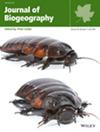The Biogeography of Invasive Exotic Vertebrates in Island Systems of the Southeast Pacific Ocean
Abstract
Aim
Biogeography and macroecology studies often require identifying the mechanisms responsible for generating exotic island biodiversity patterns. We examined the effect that physiographic (area and isolation), geographic (latitude) and anthropogenic (human population size and human population time) variables may have on the generation of invasive exotic vertebrate (IEVs) richness and composition patterns on oceanic and coastal areas.
Location
Oceanic and coastal islands of the Southeast Pacific Ocean.
Taxon
Invasive exotic vertebrates (amphibians, reptiles, birds and mammals).
Methods
We compiled data from 35 IEVs inhabiting 68 coastal and oceanic islands using different sources: our field records, online databases, environmental reports and literature. We scored the IEVs based on their impacts on native biodiversity, with scores representing minimal to massive impacts. We used univariate generalised linear mixed models and multivariate deviance analysis to describe the effect of island area, isolation, latitude, human population size and time on the richness and composition of IEVs.
Results
Island area and human population time significantly explained IEV richness, while latitude and isolation did not. For IEV composition, latitude and island area were significant predictors for all taxonomic groups. When considering only high-impact IEVs, island area and human population size significantly affected species composition. Larger islands supported more diverse IEV communities, with particular species primarily occurring on larger islands.
Main Conclusions
Classical physiographic mechanisms, particularly island areas, play a crucial role in explaining IEV richness and composition patterns on oceanic and coastal islands of the Southeast Pacific. Colonisation time and population size both significantly influence IEV richness and composition. The study highlights the importance of island characteristics and human factors in shaping IEV communities, providing insights into conservation strategies in island ecosystems.

 求助内容:
求助内容: 应助结果提醒方式:
应助结果提醒方式:


